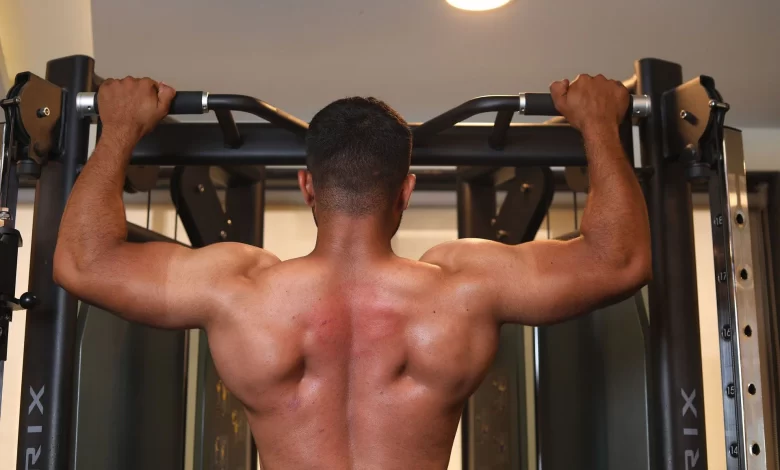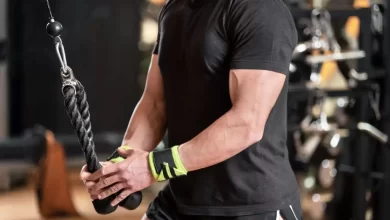
There are a lot of primary and secondary muscles you need to engage in a cable back exercises in order to fully build a well-developed back.
To build strength in a balanced manner, you’ll need to incorporate a variety of cable back exercises that target your upper and lower back muscles, including the lats, upper-mid portion of the back, lower back, and all the secondary muscles in-between. cable back exercises
The 10 Best Cable Back Exercises
Incorporating the cable back exercises into your back workout will increase your strength and muscle mass, and will also translate to better gains when you return to primary lifts like the deadlift or military press.
Here are a few of the best cable back exercises:
1. Straight-Arm Pulldown
The straight-arm pulldown is a great cable back exercises for focusing on and isolating the lats.
- Using a straight bar, grip the bar overhand, hands shoulder-width apart, and press down towards your thighs.
- Keep the core tight and focus on the lats throughout the movement.
Some people bend forward at the hips for an increased range of motion and a stretch through the shoulders at the top. If this is your first attempt at this exercise, stay lighter in weight to keep from letting your arms bend on the movement to target the right muscles before going heavier. cable back exercises
2. Face Pull
[ads1]
The face pull is a favorite for etching in and revealing the muscles of the posterior delts, traps, rhomboids, and rotator cuff muscles.
- Set the rope attachment so the pull comes eye-level.
- Pull the rope directly towards your face, keeping your elbows up and out to the sides.
- As you pull, separate your hands until the elbows travel slightly behind the back and your hands are to the sides of your head.
The movement should be slow and controlled. The face-pull simultaneously works for a shoulder program and to develop the upper back muscles.
3. Close-Grip Lat Pulldown
The close grip lat pulldown is an effective compound exercise that hits the uppers lats and increases strength throughout the entire back. Using the close-grip position increases your elbow’s range of motion. This workout is done seated, legs stabilized beneath the pad.
- Taking a close-grip, your hands should be at or closer than shoulder-width.
- Tighten your core and keep your chest up as you pull the barbell down and towards your chest.
- Be sure to pull with your lat muscles.
- Once the bar is at your chest, slowly allow it to return to the starting position keeping tension throughout the movement
4. Wide-Grip Lat Pull-downs
The most efficient back workouts will include a pull-up and/or a lat pull-down which focus on the upper back muscles. The cable lat pull-down is beneficial for building muscle mass and it works multiple muscles in this one simple exercise.
The wide-grip option of the lat pulldown targets the lats and the secondary muscles of the traps, rhomboids, and delts. To do it with correct form you’ll need to perform the movement with a slow and controlled motion. Your butt should remain in the seat throughout the movement; chest up; squeeze your elbows down and in toward your tailbone.
* Important note: do not pull the bar down behind your head when doing wide-grip lat pulldowns. Doing so can negatively affect the rotator cuffs.
5. V-Bar pulldown
The V-bar pulldown effectively hammers your lats while simultaneously targeting the lower and middle traps, rhomboids and serratus. Unlike the overhand and underhand pulldowns, the close-grip pulldown uses a V-bar attachment with a palms-facing.
- Lean your torso back slightly, knees secure under the pad as you sit, and retract your shoulder blades to bring the bar towards your chest. cable back exercises
- Keep your elbows tucked in throughout the movement and focus your attention on squeezing the lats at all times.
6. Reverse Lat Pull-Downs
The reverse-grip variation of the lat pulldown puts more focus on the lower lats by allowing you to keep your elbows tighter to the body. It’s similar to the close-grip lat pulldown with a simple change of grip from palms out to palms facing. Keep your shoulders down and resist using momentum to pull the bar. cable back exercises
7. Seated Cable Row
[ads2]
The seated cable row is another favorite back exercise with cable. It works the primary muscles specifically the lats, mid back, and traps. There’s also some emphasis on secondary muscles like the posterior delts and biceps.
The seated cable row can replace or enhance exercises like the dumbbell row and barbell bent-over row.
Keep your form strict on the cable row by pulling back the shoulder blades with each stroke.
8. One Arm Seated Cable Rows
The one-arm cable row is a variation on the seated cable row where the focus is on one side at a time. Using this method you can achieve a greater range of motion with maximized contraction of the back muscles. Adding a trunk rotation will provide an additional core workout. cable back exercises
- To do the single-arm cable row, keep your shoulders down and back.
- Rotate your wrist as you pull and remember to keep your elbow close to your body as you pull back.
This is a great addition to your workout program if you are dominant on one side of your body. The single-arm exercises will balance out your strength. cable back exercises
9. Wide-Grip Seated Cable Row
When performed properly, the wide grip row will focus more on the upper back and include more of the trapezoid, rhomboid, and rear deltoid muscles. This cable back exercises is great for building a thick upper back and also helps to correct posture problems especially or those individuals who do a lot of bench press.
- From a seated position, grasp the straight-bar attachment keeping your hands a little bit wider than shoulder-width. cable back exercises
- Keep your chest forward, shoulders down, with a slight arch in your back. cable back exercises
- With a slow, fluid movement pull the bar toward your chest making sure to squeeze and contract the muscles before returning the weight to the starting position. cable back exercises
10. Cable Reverse Fly
The cable reverse fly works as a great finisher to your workout and puts a high focus on the rhomboids and posterior delts.
- Start with a low weight until you are comfortable with the motion of the exercise. Going too heavy too soon will switch the focus to your arms rather than the rhomboids.
- You’ll face standing pulley cables, hands grasping the stirrup cable attachment at shoulder height with the cables crossed in front of you. cable back exercises
- Step back away from the machine so the cable is taut and pull the cables out to the sides.
- Keep the upper arms in a horizontal path at shoulder height and maintain stiff elbow position throughout the duration of the exercise.
Cable Back Exercises
For this workout, all you need is a cable-cross stack and a couple of different handle attachments.
This workout takes about 45 minutes from start to finish, keeping rest periods around 45-60 seconds. As your body adapts to the routine you can begin to add weight, decrease rest, or play with the order of the exercises.
1. Wide-Grip Lat Pulldown
4 sets, 8-10 reps
2. Reverse Grip Cable Pulldowns
4 sets, 8-10 reps
*If you’re looking for maximum burn and fatigue in the upper back, you can superset exercises 1 & 2. Do a set of wide-grip lat pulldown and follow it immediately with a set of reverse grip pulldowns.
3. Straight-Arm Pulldown
3 sets, 10-12 reps
Keep your tailbone tucked under and focus on using the lats to bring the bar down rather than the arms.
[ads2]
4. Face Pull
3 sets, 15 reps
Stay light on face pulls until you’re comfortable with the movement. Remember to keep a slow, controlled movement throughout the exercise and don’t let your elbows drop.
5. Seated One-Arm Cable Pulley Rows
3 sets, 10-12 reps
These can be done seated or standing. The standing variation is often called “shotgun rows” and can emphasize the stretch on the negative portion of the movement.
For the latest news and updates please follow us on Instagram.




